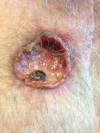Common Adult Skin and Soft Tissue Lesions
- PMID: 27478418
- PMCID: PMC4961504
- DOI: 10.1055/s-0036-1584823
Common Adult Skin and Soft Tissue Lesions
Abstract
A strong foundational knowledge of dermatologic disease is crucial for a successful practice in plastic surgery. A plastic surgeon should be able to identify and appreciate common dermatologic diseases that may require medical and/or surgical evaluation and management. In this article, the authors describe epidermal/dermal, infectious, pigmented, and malignant cutaneous lesions that are commonly encountered in practice. Descriptions include the epidemiology, pathogenesis, clinical course, and management options for each type of lesion.
Keywords: benign; common; cutaneous; dermatology; malignant.
Figures












References
-
- Bolognia J L, Jorizzo J L, Schaffer J V. Philadelphia: Elsevier Saunders; 2012. Dermatology. 3rd ed.
-
- Hafner C, Vogt T. Seborrheic keratosis. J Dtsch Dermatol Ges. 2008;6(8):664–677. - PubMed
-
- Sari R, Akman A, Alpsoy E, Balci M K. The metabolic profile in patients with skin tags. Clin Exp Med. 2010;10(3):193–197. - PubMed
-
- Fitzpatrick T B, Wolff K, Johnson R A, Suurmond D. New York: McGraw-Hill; 2005. Fitzpatrick's Color Atlas and Synopsis of Clinical Dermatology. 5th ed.
-
- Thomas V D, Snavely N R, Lee K K, Swanson N A. New York: McGraw-Hill; 2012. Benign epithelial tumors, hamartomas, and hyperplasias; p. 1334.
Publication types
LinkOut - more resources
Full Text Sources
Other Literature Sources

